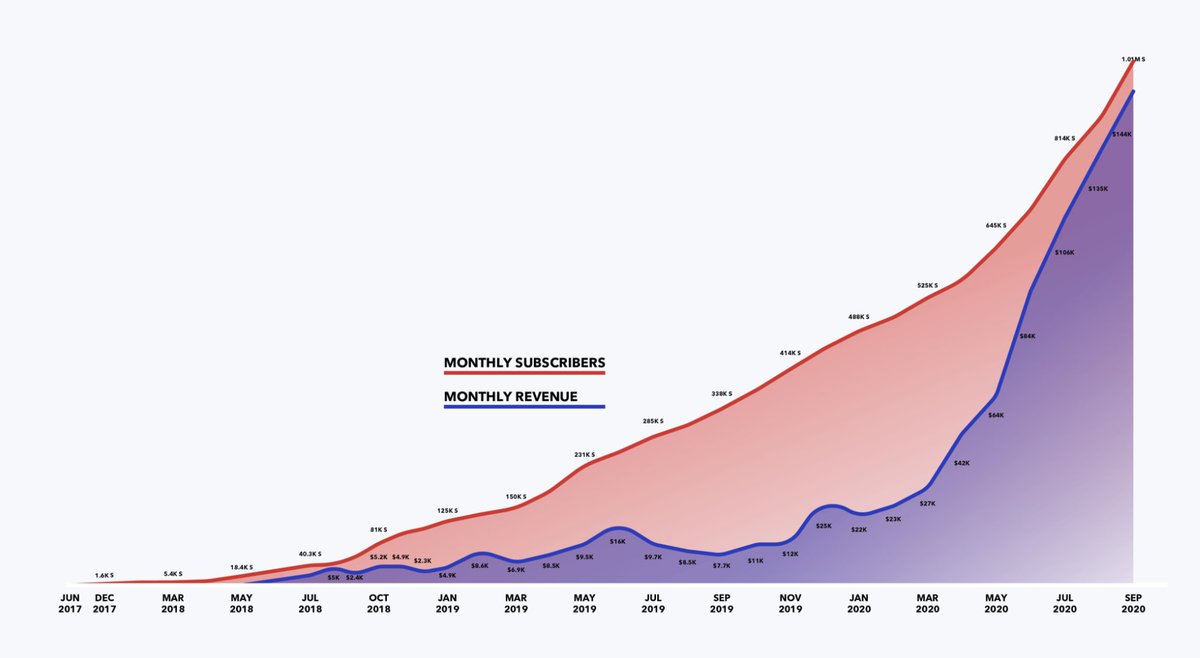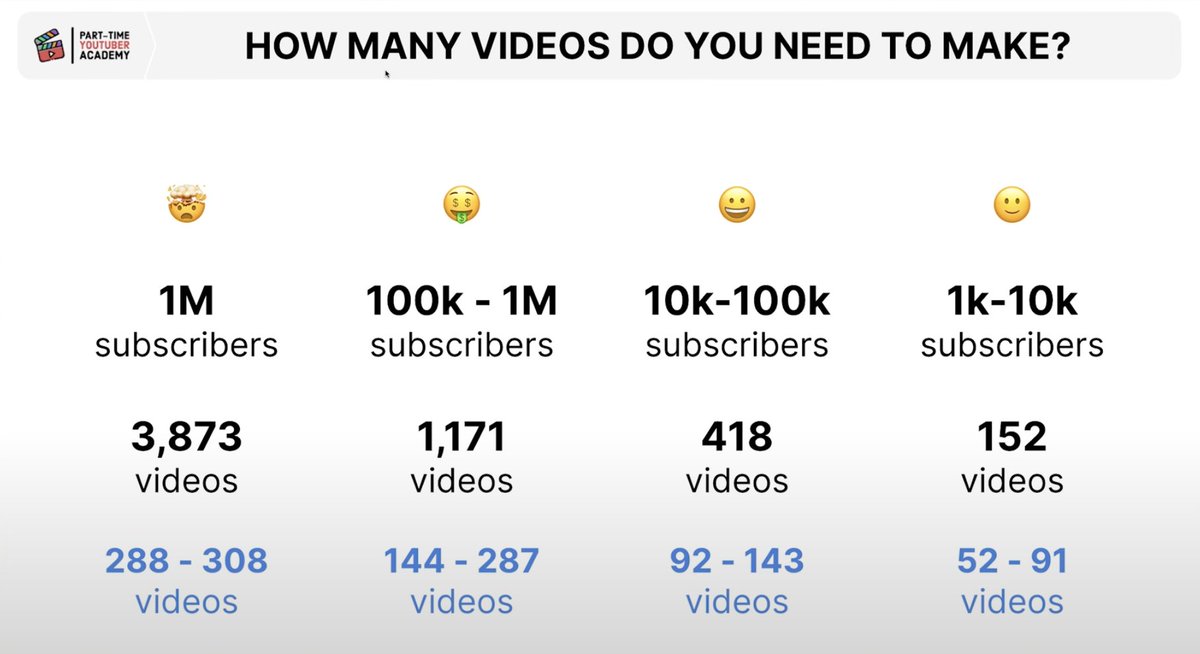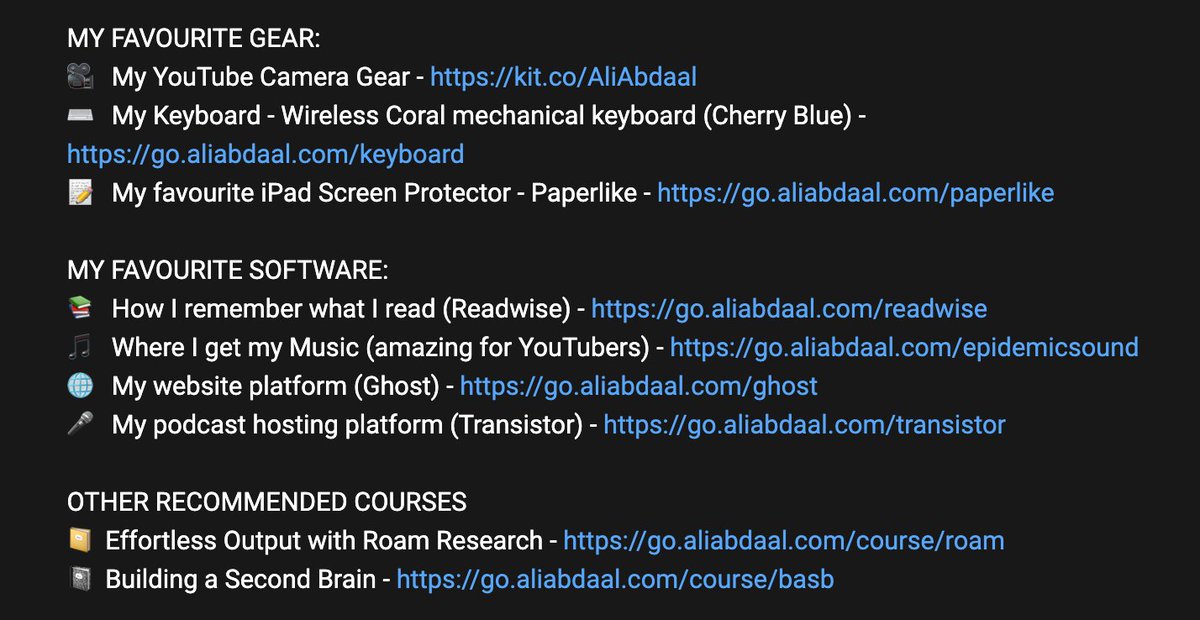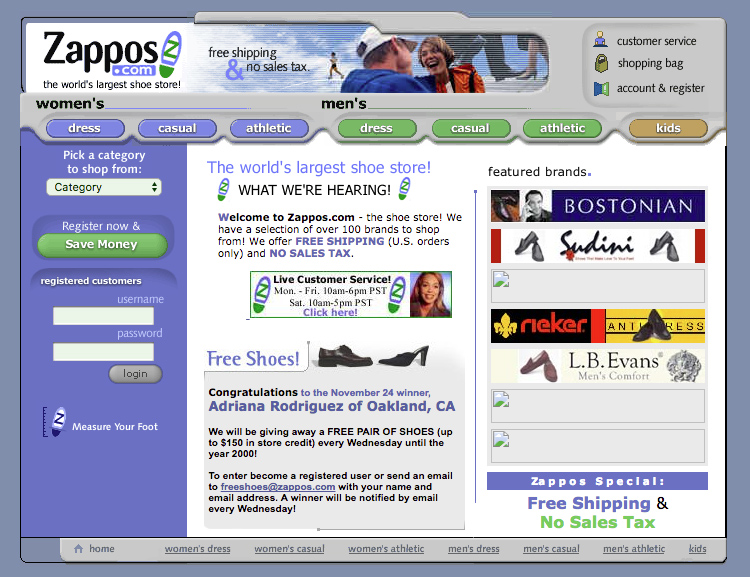The Compounding Creator
How one creator made $1,332,400 across 6 revenue streams in 2020:
🎬 $135k - Ads
🔥 $177k - Affiliates
💰 $182k - Sponsorships
📚 $470k - Self-paced courses
🚀 $295k - Cohort-based course
⭕️ $71k - Community
Breakdown 👇
How one creator made $1,332,400 across 6 revenue streams in 2020:
🎬 $135k - Ads
🔥 $177k - Affiliates
💰 $182k - Sponsorships
📚 $470k - Self-paced courses
🚀 $295k - Cohort-based course
⭕️ $71k - Community
Breakdown 👇

In 2017, @AliAbdaal created a YouTube channel.
He started with 0 views, 0 subs, but he posted 2 videos every single week for 6 months.
His revenue from this work? $0.
***This is when 95% of creators quit.***
But 52 vids and 6 months later he hit his first 1,000 subs.
He started with 0 views, 0 subs, but he posted 2 videos every single week for 6 months.
His revenue from this work? $0.
***This is when 95% of creators quit.***
But 52 vids and 6 months later he hit his first 1,000 subs.
🎬 $135,200 - Google AdSense
Channel growth:
2017: 59 vids, 1,600 subs, $0 from ads.
2018: 88 vids, 120k subs, $16,500.
2019: 62 vids, 450k subs, $44,600.
2020: 98 vids, 1.3M subs, $135,300.
More from Ali on YouTube revenue here:
Channel growth:
2017: 59 vids, 1,600 subs, $0 from ads.
2018: 88 vids, 120k subs, $16,500.
2019: 62 vids, 450k subs, $44,600.
2020: 98 vids, 1.3M subs, $135,300.
More from Ali on YouTube revenue here:
This slide shows the average number of vids needed to hit subscriber brackets (data from @TubeBuddy).
- Top row: Number of subs.
- Middle row: average vids needed to hit number of subs.
- Bottom row: Ali's vids to hit number of subs.
- Top row: Number of subs.
- Middle row: average vids needed to hit number of subs.
- Bottom row: Ali's vids to hit number of subs.

In 2017, Ali was growing at 2X the average, with 27 subs and $0 per vid.
By 2020, he was growing at 10X the average, with 8,673 subs and $1,380 per vid.
But, his output remained steady at ~1.5 vids per week. This is the compounding nature of sub and revenue growth.
By 2020, he was growing at 10X the average, with 8,673 subs and $1,380 per vid.
But, his output remained steady at ~1.5 vids per week. This is the compounding nature of sub and revenue growth.
🔥 $177,900 - Affiliates
Affiliate rev: when you promote a product and receive a commission on any sales.
It's generally better to sell your own products (higher margin), but selling other people's products can be lucrative too.
Some of Ali's affiliate products:
Affiliate rev: when you promote a product and receive a commission on any sales.
It's generally better to sell your own products (higher margin), but selling other people's products can be lucrative too.
Some of Ali's affiliate products:

💰 $182,600 - Brand sponsorships
It took Ali 1 year, 120 vids, and 50k subs to find his first sponsor.
Sponsors usually pay $20 - $30 CPM (per 1k) views.
Ali's sponsorship revenue growth:
2017: $0
2018: $7,700
2019: $42,000
2020: $182,600
It took Ali 1 year, 120 vids, and 50k subs to find his first sponsor.
Sponsors usually pay $20 - $30 CPM (per 1k) views.
Ali's sponsorship revenue growth:
2017: $0
2018: $7,700
2019: $42,000
2020: $182,600
📚 $470,100 - Self-paced online courses
Online courses are Ali's largest income stream. He hosts his courses on SkillShare.
Ali's course stats:
- 7 courses created
- 100k students
- $5 revenue per student
His courses:
skillshare.com/user/aliabdaal
Online courses are Ali's largest income stream. He hosts his courses on SkillShare.
Ali's course stats:
- 7 courses created
- 100k students
- $5 revenue per student
His courses:
skillshare.com/user/aliabdaal
🚀 $295,500 - Cohort-based course (CBC)
Ali created a CBC: Part-Time YouTuber Academy.
CBC's are typically time-based with a multi-week schedule, live Zoom calls, and a community.
PTYA had 360 students for an avg of ~$800 per student.
academy.aliabdaal.com
Ali created a CBC: Part-Time YouTuber Academy.
CBC's are typically time-based with a multi-week schedule, live Zoom calls, and a community.
PTYA had 360 students for an avg of ~$800 per student.
academy.aliabdaal.com
⭕️ $71,100 - Paid community
Following the success of his cohort-based course, Ali created an inner circle community for alumni students to stay in touch, collaborate, and provide ongoing support.
He charges $50/m, and has 124 members.
Following the success of his cohort-based course, Ali created an inner circle community for alumni students to stay in touch, collaborate, and provide ongoing support.
He charges $50/m, and has 124 members.

That's a total of $1,362,000 across 6 revenue streams that are all interconnected.
What can creators learn from Ali?
Here are a few lessons:
What can creators learn from Ali?
Here are a few lessons:
The Secret to 100,000+ Subscribers:
Ali guarantee's this simple formula will change your life...
1. Create content that your audience finds valuable
2. Publish 1-2 times per week
3. Do this for 2 years
Do that, and the score takes care of itself.
Ali guarantee's this simple formula will change your life...
1. Create content that your audience finds valuable
2. Publish 1-2 times per week
3. Do this for 2 years
Do that, and the score takes care of itself.
https://twitter.com/david_perell/status/1267488034066501634
Success = 🧑💻 x 🍀 x ⭐️
🧑💻 Work = Provide value.
🍀 Luck = Make your own luck through consistency.
⭐️ Unfair advantages = leverage your unique experiences, skills, and perspective.
🧑💻 Work = Provide value.
🍀 Luck = Make your own luck through consistency.
⭐️ Unfair advantages = leverage your unique experiences, skills, and perspective.
Work:
Be consistently good. Figure out what resonates with your audience. Be entertaining. Be insightful. Iterate.
Ali has continued to improve his production quality and storytelling skills, and it shows.
There is no shortcut to providing value.
Be consistently good. Figure out what resonates with your audience. Be entertaining. Be insightful. Iterate.
Ali has continued to improve his production quality and storytelling skills, and it shows.
There is no shortcut to providing value.
Luck:
@garyvee once said, "one piece of content can change your life."
Ali creates luck by posting 2 vids/week consistently over 3 years — and he's had multiple videos go viral.
@garyvee once said, "one piece of content can change your life."
Ali creates luck by posting 2 vids/week consistently over 3 years — and he's had multiple videos go viral.
https://twitter.com/david_perell/status/1233959744462819329
Unfair advantages:
What do you bring to the table that others don't? Experiences, skills, perspective, network, status, capital?
Stack the deck in your favor by leveraging your unique assets.
What do you bring to the table that others don't? Experiences, skills, perspective, network, status, capital?
Stack the deck in your favor by leveraging your unique assets.
Ali leveraged 2 advantages:
1. Experience and status
Ali was a med student at Cambridge, so he started creating vids about med school at Cambridge.
He expanded into interview tips for med students, then vlogs about med student life.
Now he's expanded to productivity & tech.
1. Experience and status
Ali was a med student at Cambridge, so he started creating vids about med school at Cambridge.
He expanded into interview tips for med students, then vlogs about med student life.
Now he's expanded to productivity & tech.
2. Skills
He had been doing graphic and web design since 12.
When he started making YouTube videos at 23, he had 11 years of experience honing his eye for design and a skillset to execute.
He had been doing graphic and web design since 12.
When he started making YouTube videos at 23, he had 11 years of experience honing his eye for design and a skillset to execute.
Give before you ask:
Ali published 59 vids before he made $1.
Without an audience, it's hard to get people to buy from you if they don't know, like, or trust you.
The easiest way to build one, is to create and share free valuable content regularly.
Ali published 59 vids before he made $1.
Without an audience, it's hard to get people to buy from you if they don't know, like, or trust you.
The easiest way to build one, is to create and share free valuable content regularly.
https://twitter.com/JamesClear/status/1326664341186355200
Find a product for your audience, not an audience for your product.
Ali's PTYA course only exists because of his own lessons building a successful YT channel. The inner-circle product only came about by listening to his PTYA customers.
Ali's PTYA course only exists because of his own lessons building a successful YT channel. The inner-circle product only came about by listening to his PTYA customers.
https://twitter.com/jackbutcher/status/1333925340767531009
Segment prices to match audience segments.
The majority of Ali's audience are not a good fit for his cohort-based course. But a segment of his audience is willing to pay a premium price to learn from him.
Ali sells products at low as $5 and high as $1k+.
The majority of Ali's audience are not a good fit for his cohort-based course. But a segment of his audience is willing to pay a premium price to learn from him.
Ali sells products at low as $5 and high as $1k+.
Relentlessly focus on one channel:
Ali now has 6 income streams, a blog, a newsletter, and a podcast (@noverthinking).
But he spent years creating hundreds of YT vids first, it's still his primary channel. Most of his success can be derived from his YT channel.
Ali now has 6 income streams, a blog, a newsletter, and a podcast (@noverthinking).
But he spent years creating hundreds of YT vids first, it's still his primary channel. Most of his success can be derived from his YT channel.
Become an overnight success in 14 years:
Ali started working on the internet at age 12. He's now 26.
He spent years creating multiple online businesses that all failed.
His first taste of success took years to come by.
More on that here:
Ali started working on the internet at age 12. He's now 26.
He spent years creating multiple online businesses that all failed.
His first taste of success took years to come by.
More on that here:
Find what feels like play to you but work to others:
Ali persevered for years before finding success. Most people would have quit many times along the way. He was able to keep going because he genuinely enjoyed the journey.
Ali persevered for years before finding success. Most people would have quit many times along the way. He was able to keep going because he genuinely enjoyed the journey.
https://twitter.com/naval/status/1343375934473138177
The most successful teachers of the future will be entrepreneurs.
Ali made $836k from teaching alone. Topics: Studying, productivity, stoicism, YouTube, cooking.
Is he the best teacher in the world on these topics? No. But his entrepreneurial mindset makes all the difference.
Ali made $836k from teaching alone. Topics: Studying, productivity, stoicism, YouTube, cooking.
Is he the best teacher in the world on these topics? No. But his entrepreneurial mindset makes all the difference.
Lastly, you don't have to quit your day job to become a successful creator:
The twist in Ali's story?
Up until August, he worked full-time as a doctor. Before that, he was a full-time med student.
That's right, he did all of this in his spare time 🤯.
The twist in Ali's story?
Up until August, he worked full-time as a doctor. Before that, he was a full-time med student.
That's right, he did all of this in his spare time 🤯.
How?
Time management. Ali is a productivity fanatic. He's shared many of his methods on his channel:
Leverage. He hired 2 full-time employees to help him this year, but he also built up systems to scale and maximize efficiency.
Time management. Ali is a productivity fanatic. He's shared many of his methods on his channel:
Leverage. He hired 2 full-time employees to help him this year, but he also built up systems to scale and maximize efficiency.
Where to from here? Merch.
@AliAbdaal's connection with his audience is authentic. His personal brand has huge potential.
To capitalize, he should follow in the footsteps of Jordan and Kanye by releasing a @Gymshark shoe.
ha, just kidding... unless..?
@AliAbdaal's connection with his audience is authentic. His personal brand has huge potential.
To capitalize, he should follow in the footsteps of Jordan and Kanye by releasing a @Gymshark shoe.
ha, just kidding... unless..?
https://twitter.com/JoePompliano/status/1298057084550995970
Hat tip to @AliAbdaal for being so transparent and vulnerable. 👏
Sharing insight into your business takes balls, but is so inspiring to new and old creators. There's nothing like seeing real people share real numbers.
Watch the full video here:
Sharing insight into your business takes balls, but is so inspiring to new and old creators. There's nothing like seeing real people share real numbers.
Watch the full video here:
If you enjoyed this thread and want to learn more about the Creator Economy space:
1. Follow me @ryangum
2. Subscribe to my upcoming posts for more insights:
ryangum.com
1. Follow me @ryangum
2. Subscribe to my upcoming posts for more insights:
ryangum.com
• • •
Missing some Tweet in this thread? You can try to
force a refresh









